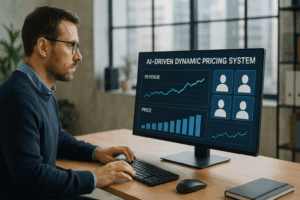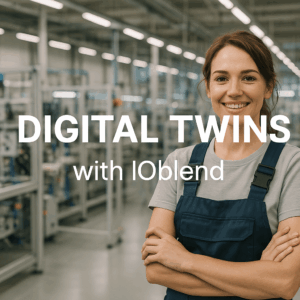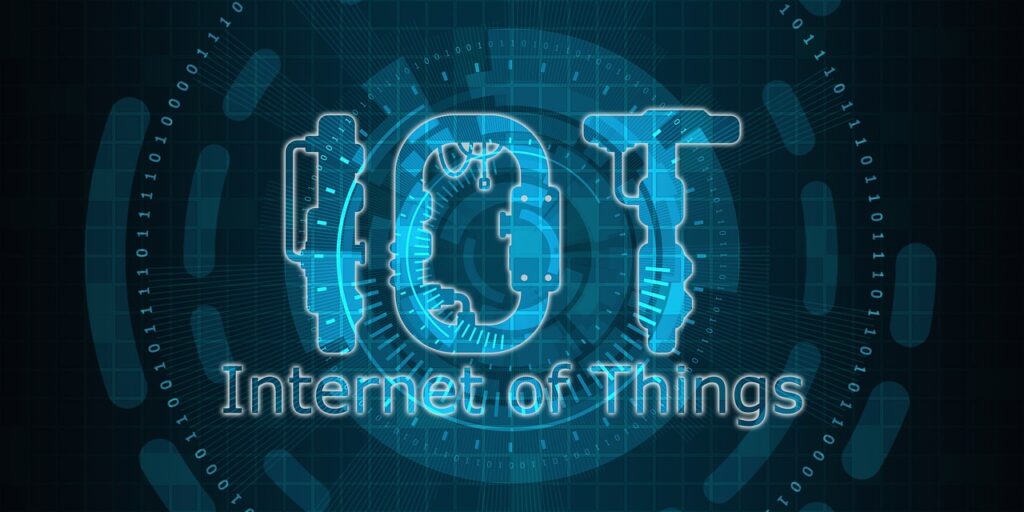How IOblend Enables Real-Time Analytics of IoT Data
The Internet of Things (IoT) is reshaping how we interact with the world around us. IoT refers to the network of physical objects – “things” – embedded with sensors, software, and other technologies, aiming to connect and exchange data with other devices and systems over the internet. These devices range from ordinary household items to sophisticated industrial tools and everything in between.
Where do you find IoT?
IoT finds its application in various sectors, contributing significantly to making our lives more connected and efficient. In smart homes, for instance, IoT devices can control lighting, heating, and air conditioning, offering convenience and energy efficiency. In healthcare, wearable devices monitor patient health metrics in real-time, enabling proactive healthcare management.
Smart cities utilise IoT for everything from monitoring traffic and pollution levels to managing energy use in buildings. Aviation relies heavily on a wide range of sensor data to monitor safety, enhance efficiency, and optimise operational performance.
Analysing IoT Data
The real power of IoT lies in the data it generates in real-time. This data is continuously analysed to derive meaningful insights, mainly by automated systems.
For instance, in retail, data from IoT devices helps in tracking inventory levels in real-time, optimising stock management. More advanced implementations enable dynamic up-sales as the customer is browsing the goods.
Similarly, in a smart factory, data from various sensors on machines are analysed to predict equipment failures before they occur (predictive maintenance). IOblend has successfully enabled just such analytics use case with a large healthcare provider, moving them from a manual weekly batch ingest to real-time streaming data that now feeds their predictive algorithms.
How is Data from IoT Devices Analysed?
The analysis of IoT data involves collecting, processing, and interpreting the data from various sources, predominantly in real-time. This is where Big Data technologies and advanced analytics come into play.
Since the data flows in real time, it must be robust and reliable throughout the dataflow, source to destination.
This means multiple quality-ensuring processes must be applied to the streaming data also in real time, such as data logging at record level, error checking, drift monitoring, data lineage and management of late arriving data. On top of that, you need to be able to perform complex transformations and data enrichment from other systems, while ensuring the output of these data pipelines is robust too.
Data scientists can then use machine learning algorithms to find patterns and make predictions based on IoT data.
How Does IOblend Support IoT?
IOblend steps into the IoT framework as a crucial facilitator for managing and moving real-time streaming data. Given the vast amount of data generated by IoT devices, handling this data efficiently is paramount. IOblend, with its robust data integration capabilities and seamless scalability, can handle any IoT data quantity or number of devices.
Real-Time Data Integration: IoT devices, say, smart meters, generate massive volumes of data at high speeds. Handling and processing this data efficiently are a significant challenge. Just ask any of the service providers.
IOblend excels in integrating real-time data from IoT devices like these. In a clean-sheet application, all incoming data is processed in-memory end-to-end within a single tool to reduce latency and integration complexities. But IOblend can slot into the existing architecture, like channelling data into a warehouse for processing and consumption, but with the added benefits of data lineage, CDC, regressions, and quality checks.
IOblend sits atop of Spark with all its powerful features and capabilities but requires no coding. We have abstracted all the coding, deployment, and management complexities away. We also added several performance enhancements and efficiency gains so to process in excess of 10m records per sec on even the most modest hardware.
Data Management and Governance: With IoT, data security and governance become critical concerns. IOblend ensures that the data streaming from IoT devices is managed securely, adhering to compliance and governance standards. Data quality rules are applied in-flight and any anomalies are instantly detected.
Scalability and Flexibility: The scalability of IOblend makes it a perfect match for IoT applications, where the number of devices and the volume of data can escalate rapidly. Component replication and reuse is very simple, and each data pipeline adheres to the strict CI/CD principles for each deployment.
Streamlining Data Pipelines: IOblend’s capacity to create efficient data pipelines facilitates the smooth transfer of data from IoT devices to the platforms where it’s analysed. This enhances the overall efficiency of IoT systems.
Data Analysis and Insights: Beyond mere data integration, IOblend’s capabilities extend to aiding in the analysis of data. Our partnerships with platforms like Snowflake and MS Azure demonstrate the strengths in managing Big Data, crucial for deriving robust insights from IoT data.
IOblend is Here to Enable Your IoT?
IOblend is a highly scalable platform, able to handle large amounts of data and lots of small data, batch and streaming. We reduced development time from weeks and months to days and hours. Once the data pipelines are in production, very little supervision is required due to the high degree of system automation. You manage your data issues “by exception”. We strongly believe in the principle of “build once, build to last”.
Drastically lower your IoT analytics development effort and cost. What took months now takes days. Totally platform-agnostic and can integrate with all systems and data sources. The advanced data capabilities you always wish you could have, are now within an easy reach.
Get in touch today. Let’s discuss how we can unlock your IoT analytics capabilities.
IOblend presents a ground-breaking approach to IoT and data integration, revolutionizing the way businesses handle their data. It’s an all-in-one data integration accelerator, boasting real-time, production-grade, managed Apache Spark™ data pipelines that can be set up in mere minutes. This facilitates a massive acceleration in data migration projects, whether from on-prem to cloud or between clouds, thanks to its low code/no code development and automated data management and governance.
IOblend also simplifies the integration of streaming and batch data through Kappa architecture, significantly boosting the efficiency of operational analytics and MLOps. Its system enables the robust and cost-effective delivery of both centralized and federated data architectures, with low latency and massively parallelized data processing, capable of handling over 10 million transactions per second. Additionally, IOblend integrates seamlessly with leading cloud services like Snowflake and Microsoft Azure, underscoring its versatility and broad applicability in various data environments.
At its core, IOblend is an end-to-end enterprise data integration solution built with DataOps capability. It stands out as a versatile ETL product for building and managing data estates with high-grade data flows. The platform powers operational analytics and AI initiatives, drastically reducing the costs and development efforts associated with data projects and data science ventures. It’s engineered to connect to any source, perform in-memory transformations of streaming and batch data, and direct the results to any destination with minimal effort.
IOblend’s use cases are diverse and impactful. It streams live data from factories to automated forecasting models and channels data from IoT sensors to real-time monitoring applications, enabling automated decision-making based on live inputs and historical statistics. Additionally, it handles the movement of production-grade streaming and batch data to and from cloud data warehouses and lakes, powers data exchanges, and feeds applications with data that adheres to complex business rules and governance policies.
The platform comprises two core components: the IOblend Designer and the IOblend Engine. The IOblend Designer is a desktop GUI used for designing, building, and testing data pipeline DAGs, producing metadata that describes the data pipelines. The IOblend Engine, the heart of the system, converts this metadata into Spark streaming jobs executed on any Spark cluster. Available in Developer and Enterprise suites, IOblend supports both local and remote engine operations, catering to a wide range of development and operational needs. It also facilitates collaborative development and pipeline versioning, making it a robust tool for modern data management and analytics

ERP Cloud Migration With Live Data Sync
Seamless Core System Migration: The Move of Large-Scale Banking and Insurance ERP Data to a Modern Cloud Architecture ⛅ Did you know that core system migrations in large financial institutions, which typically rely on manual data mapping and validation, often require parallel runs lasting over 18 months? The Core Challenge The migration of multi-terabyte ERP and

Legacy ERP Integration to Modern Data Fabric
Warehouse Automation Efficiency: Migrating and Integrating Legacy ERP Data into a Modern Big Data Ecosystem 📦 Did you know? Analysts estimate that warehouses leveraging robust, real-time data integration see inventory accuracy improvements of up to 99%. The Convergence of WMS and Big Data Data professionals in logistics face a profound challenge extracting mission-critical operational data such

Dynamic Pricing with Agentic AI
The Agentic Edge: Real-Time Dynamic Pricing through AI-Driven Cloud Data Integration 📊 Did You Know? The most sophisticated dynamic pricing systems can process and react to market signals in under 100 milliseconds. The Evolution of Value Optimisation Dynamic Pricing and Revenue Management (DPRM) is a complex computational science. At its core, DPRM aims to sell the right

Smarter Quality Control with Cloud + IOblend
Quality Control Reimagined: Cloud, the Fusion of Legacy Data and Vision AI 🏭 Did You Know? Over 80% of manufacturing and quality data is considered ‘dark’ inaccessible or siloed within legacy on-premises systems, dramatically hindering the deployment of real-time, predictive Quality Control (QC) systems like Vision AI. Quality Control Reimagined The core concept of modern quality

Predictive Aircraft Maintenance with Agentic AI
Predictive Aircraft Maintenance: Consolidating Data from Engine Sensors and MRO Systems 🛫 Did you know that leveraging Big Data analytics for predictive aircraft maintenance can reduce unscheduled aircraft downtime by up to 30% Predictive Maintenance: The Core Concept Predictive Maintenance (PdM) in aviation is the strategic shift from a time-based or reactive approach to an ‘as-needed’ model,

Digital Twin Evolution: Big Data & AI with
The Industrial Renaissance: How Agentic AI and Big Data Power the Self-Optimising Digital Twin 🏭 Did You Know? A fully realised industrial Digital Twin, underpinned by real-time data, has been proven to reduce unplanned production downtime by up to 20%. The Digital Twin Evolution The Digital Twin is a sophisticated, living, virtual counterpart of a physical production system. It

